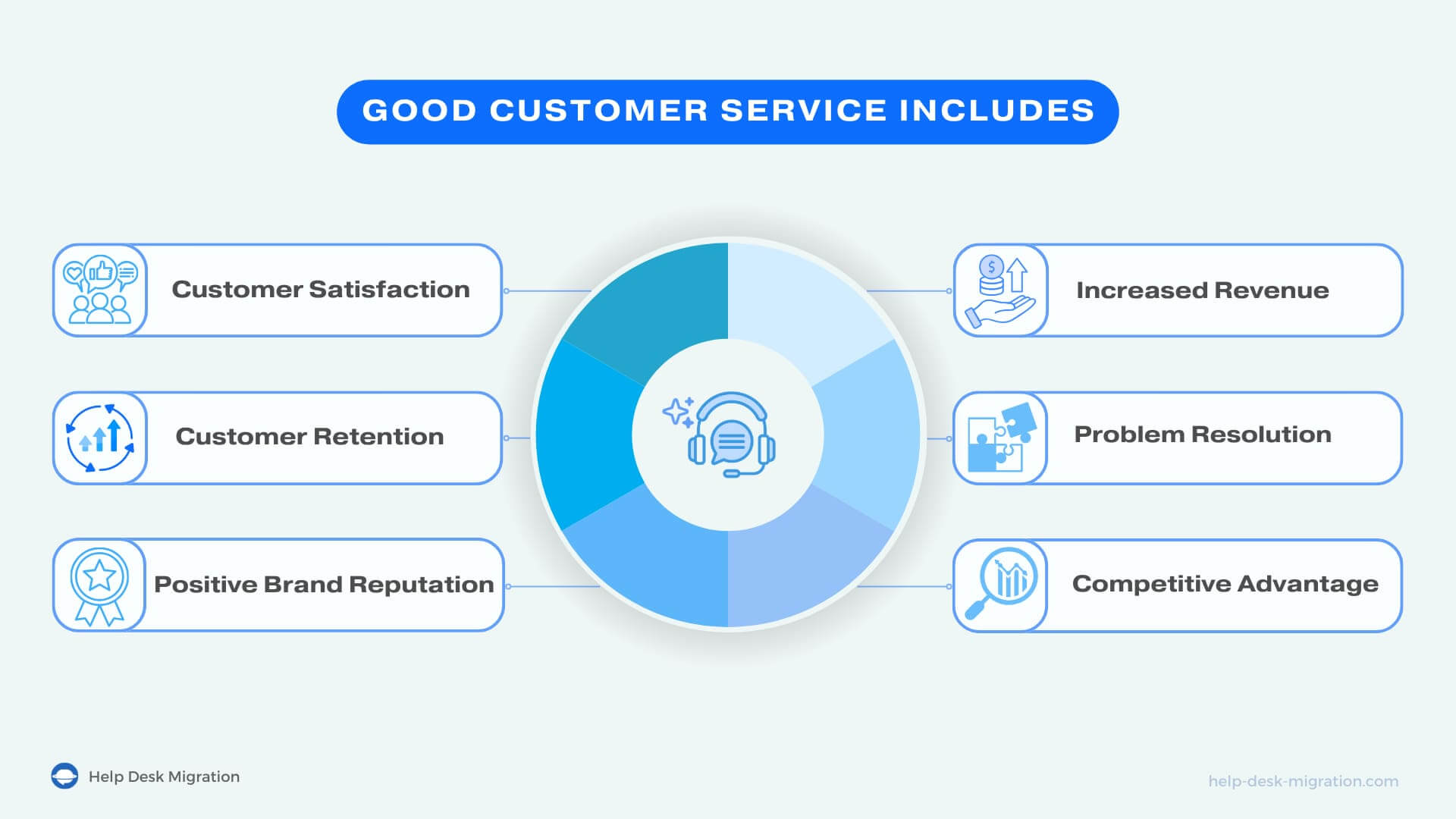Customer support is an integral part of a great customer experience. For customers, it isn’t a luxury but a necessity. It helps you achieve high customer satisfaction, leading to a better brand image and higher sales.
After finishing this article, you’ll know:
- Why good customer support is a must
- 11 fatal customer service mistakes to avoid
- What causes customer service mistakes
- Best practices for customer support that fix these mistakes
- How Help Desk Migration can improve your customer support
Let’s see how you can improve your customer service and prevent customer support mistakes.
Why provide good customer service?
They say, “the customer is always right,” and that means someone else has to be wrong. As a product or service provider, that someone just might be you. There are plenty of reasons customers call customer support agents: unclear instructions, poor product quality, rude staff, and so on.
Whatever the reason, when they reach out, customer satisfaction is in danger and your customer support team is the last bastion between you and a lost client. Here’s how customer support heroes contribute to the success of your business.

Customer retention
According to a 2020 Salesforce survey, 92% of consumers and 89% of business buyers were more likely to buy additional products after a positive customer experience. Moreover, 78% of customers will overlook some problems if they receive excellent support.
Customer advocacy and positive brand image
Good customer support creates a positive brand image and turns customers into company advocates. A 2023 Champion HQ survey of top SaaS companies found that 81% of sales leaders and 65% of marketing leaders agreed that more references from brand advocates lead to more closed deals.
Increased revenue
More sales and retention lead to higher revenue. Plus, satisfied customers spend up to 140% more than unsatisfied ones.
Competitive advantage
According to HubSpot’s 2022 report, only 50% of businesses use even basic support tools, let alone advanced tools. This means you can beat half of your competition simply by implementing the most basic customer service practices.
Employee satisfaction
Good customer support also has a tremendous effect on your employees’ satisfaction. Your support team gains a strong sense of purpose when they know that their work directly impacts customer satisfaction. Seeing good customer reviews and feedback tells your team that their efforts improved customers' experiences, which gives the team a strong sense of purpose, and in turn, boosts morale and job satisfaction at your company.
How to fix customer service mistakes with best practices for customer support
Now that you know why good customer support is so important, let’s look at the 11 jarring customer service mistakes many businesses make and the best practices for customer support to avoid them.
| Customer Service Mistake | Description | How to Fix It |
| Not Responding Promptly | Delayed responses lead to customer frustration and potential churn. | Set clear response time goals, implement efficient tools, ensure adequate staffing, and offer self-service options. Monitor metrics for improvements. |
| Providing Inaccurate Information | Incorrect info can frustrate customers and damage trust. | Train staff, audit processes, create up-to-date knowledge resources, and establish clear escalation procedures. |
| Lack of Personalization | Over-reliance on scripts leads to impersonal interactions, affecting customer satisfaction. | Use help desk data to understand customer preferences, encourage authentic communication, and use AI tools to assist in personalizing responses. |
| Overcomplicating Processes | Complex systems reduce efficiency and frustrate customers. | Streamline processes, offer self-service options, and empower reps to resolve issues independently. |
| Not Utilizing Data | Ignoring data prevents optimization and resource allocation, leading to poor customer outcomes. | Regularly analyze data to identify trends and inform strategic decisions. Foster a culture of continuous improvement. |
| Lack of Training | Poorly trained agents deliver unsatisfactory service, increasing customer frustration. | Provide ongoing training, conduct regular performance reviews, and foster a culture of learning. |
| Neglecting Multichannel Support | Limited communication options frustrate customers and lead to inefficiencies. | Identify key channels, integrate them for cohesive support, and ensure customer data is accessible across channels. |
| Overpromising and Underdelivering | Failure to meet promises harms trust and leads to reputational damage. | Set realistic service-level agreements, monitor performance, and implement QA processes to ensure delivery. |
| Transferring Customers | Multiple transfers frustrate customers and waste resources. | Train agents to resolve a wider range of issues, use clear protocols, and implement intelligent routing systems. |
| Not Providing Adequate Follow-Up | Failing to follow up leaves customers feeling unheard and increases support costs. | Establish follow-up protocols, track cases, and ensure agents update customers on resolution. |
| Lack of Automation Tools | Without automation, teams struggle with high inquiry volumes, leading to delays and higher costs. | Identify automation opportunities, implement tools gradually, and ensure they integrate with existing systems. |
1. Not responding promptly
Failing to respond to customer inquiries promptly is a widespread customer support mistake that can have significant negative consequences for your business. Customers expect timely assistance, and delayed responses can lead to frustration, lost trust, and potential customer churn. When customers wait too long for a response, they may feel that your company doesn’t take their concerns seriously.
How to fix it:
- Establish clear response time goals and communicate them to customers. For example, “We aim to respond to all inquiries within 24 hours.”
- Implement efficient processes and tools, like a ticketing system or help desk software for CS.
- Ensure adequate staffing levels and training so your customer support team can handle inquiries promptly and efficiently.
- Offer self-service options like a website knowledge base or FAQ section for customers to find answers without waiting.
- Monitor and analyze customer support metrics, like response times and customer satisfaction, to identify areas for improvement and allocate resources accordingly.
2. Providing inaccurate information
Customers rely on your support team’s information to make decisions and resolve issues. Providing incorrect information is a significant customer support mistake that can cause various problems, including:
- Frustrated customers.
- Wasted time and resources of customers who have to follow up or seek alternative solutions.
- Potential legal and regulatory issues if inaccurate information causes physical or financial harm to a customer.
- Damage to the company's reputation.
How to fix it:
- Train your customer support team to understand your products, services, and policies.
- Implement quality assurance processes like regular audits and spot-checks.
- Create detailed and up-to-date knowledge resources, like a comprehensive FAQ or a searchable knowledge base for customers.
- Encourage a culture of transparency and accountability, where employees admit customer service mistakes and work together to correct errors.
- Establish clear escalation procedures to handle complex inquiries to ensure that customers receive timely and accurate information.
3. Lack of personalization
Many companies fall into the trap of relying heavily on scripts and canned responses that don’t consider individual customer needs or contexts. Although scripts maintain consistency, over-reliance on them leads to robotic interactions that fail to engage customers.
The consequences can be significant:
- Customers feel undervalued and frustrated when their concerns aren’t addressed.
- Impersonal service can damage a brand's image.
- Without personalized interactions, support teams may miss chances to upsell or cross-sell products.
- Support reps may feel disengaged and frustrated when restricted to scripts, leading to lower job satisfaction and productivity.
How to fix it:
- Train customer support representatives to use scripts as guidelines rather than strict rules. Encourage them to engage with customers authentically and to adapt their responses based on the conversation.
- Use help desk systems to gather and analyze customer data to gain a better understanding of individual customer preferences and history.
- Train customer support agents to practice active listening so they’ll understand customer concerns better and respond appropriately.
- Solicit customer feedback to refine support processes and improve personalization.
- Consider using AI and machine learning tools to analyze customer interactions and provide personalized recommendations that help human representatives engage meaningfully.
4. Overcomplicating processes
Complex support systems frustrate customers, reduce team efficiency, and increase operational costs.
How to fix it:
- Streamline your CS processes.
- Implement self-service options, chatbots, and automated tools so customers can handle routine inquiries and tasks on their own. This frees up customer support agents for complex issues.
- Don’t forget the personalized approach for niche problems.
- Give customer support reps the authority and resources to resolve issues without needing to escalate or go through multiple levels of approval.
5. Not utilizing data
Without analyzing data on things like common inquiries, resolution times, and customer satisfaction, you miss valuable insights that you can use to improve your customer support. Plus, you may allocate resources inefficiently, leading to long wait times, high support costs, and subpar customer outcomes.
How to fix it:
- Review data regularly to identify trends, pain points, and opportunities for improvement.
- Use data to inform strategic decisions.
- Share your insights with your organization to foster a culture of continuous improvement.
- Experiment with new approaches and monitor their impact on CS KPIs.
6. Lack of training
Poorly trained customer support agents are more likely to deliver an unsatisfactory experience by providing inaccurate information and failing to resolve customer issues. Customers can become frustrated and lose trust in the company if they repeatedly encounter support representatives who lack the knowledge and skills to resolve their issues.
Unresolved customer issues can lead to more support calls, higher operational costs, and damage to the company's reputation. Lack of training is an avoidable customer support mistake that can also lead to low morale and high staff turnover, which can worsen the problem.
How to fix it:
- Develop onboarding and ongoing training for customer support representatives.
- Implement regular performance reviews and feedback to identify training gaps and provide personalized support.
- Foster a culture of continuous learning and knowledge sharing within the team.
- Regularly assess training program effectiveness and adjust based on employee and customer feedback and business needs.
7. Neglecting multichannel support
Customers expect flexibility in communication channels. A lack of communication options can lead to:
- Frustrated customers who can’t reach support through their preferred communication channel.
- Potential loss of customers who seek support from more responsive competitors.
- Fewer opportunities to collect customer data that offer insights.
- Increased operational inefficiencies.
How to fix it:
- Identify the key communication channels your customer base uses, including phone, email, live chat, social media, and self-service options.
- Integrate these communication channels for cohesive support.
- Ensure customer information and support history are accessible across all communication channels for a supreme customer experience.
8. Overpromising and underdelivering
Overpromising and underdelivering can damage customer trust, satisfaction, and loyalty. The impact is shattering:
- Negative word-of-mouth and reputational damage can deter customers.
- Extra resources, higher support costs, and operational inefficiencies due to unmet promises, that customer support agents will have to spend time addressing.
How to fix it:
- Establish and communicate clear, realistic service-level agreements to set proper expectations.
- Continuously monitor and assess your company's ability to meet expectations.
- Implement QA processes to identify and address gaps between promised and actual experiences.
- Foster a culture of accountability, where support staff manage customer expectations proactively and escalate issues that may impact the company's ability to deliver.
9. Transferring customers from agent to agent
Being transferred multiple times during one interaction is frustrating. It’s even worse if the problem isn’t resolved in the end. Other issues include:
- Increased operational costs and reduced productivity and efficiency for the customer support team—representatives spend time transferring calls instead of resolving issues.
- The company’s inability to organize the customer journey diminishes customer trust and loyalty to your company.
How to fix it:
- Implement a comprehensive training program to ensure customer support reps feel confident resolving a wide range of inquiries without transferring calls to other agents.
- Establish clear protocols and decision trees to guide representatives on customer transfers.
- Use advanced technologies like intelligent routing and knowledge management systems to direct customers to the best representative or self-service resource.
10. Not providing adequate follow-up
Neglecting to follow up with customers after an interaction can leave them feeling unheard, unsupported, and less likely to continue doing business with the company:
- Loss of customer trust and damage to the company's reputation because customers see the business as unresponsive or indifferent.
- Missed chances to gather feedback and improve customer support.
- When issues escalate due to a lack of timely follow-ups, it leads to increased support costs.
How to fix it:
- Establish clear follow-up protocols and timelines to ensure timely updates and follow-ups.
- Empower customer support reps to own the entire customer journey, holding them accountable for follow-up and issue resolution.
- Implement tracking and ticketing systems to monitor customer cases and generate follow-up reminders.
- Encourage customer support agents to update customers, get feedback, and ensure customer satisfaction.
11. Lack of automation tools
Many companies overlook automation tools and hesitate to implement new technologies for customer support. But forgoing automation tools can have substantial consequences:
- Support teams may struggle with the volume of inquiries, leading to longer hold times and delayed resolutions.
- Manual processes require more staffing and training resources, which drives up costs.
- Support representatives can spend valuable time on repetitive tasks, which can affect employee morale and retention.
How to fix it:
- Identify areas where automation could streamline operations, like ticket routing, knowledge base creation, and customer segmentation.
- Explore automation tools and platforms that fit your company's needs and budget. Consider factors like integration with existing systems, customization options, and customer support from providers.
- Introduce automation tools gradually, starting with low-risk areas. This helps familiarize your support teams with the new technology and identify potential issues before scaling up.
What causes customer service mistakes?
Every customer service mistake has an underlying issue, some of which we touched on in the previous section. Let’s examine the common issues causing customer service mistakes.
Lack of training
Dedication alone will take a team only so far; your staff also needs proper training. Comprehensive onboarding and continuous training keep agents up-to-date on CS trends and developments.
Foster a culture of learning and self-improvement to motivate your team and encourage professionalism. Help them improve by offering specialized courses, trainings, and knowledge repositories.
Poor communication within the team
When everyone is doing their own thing, uncoordinated and alone, the consistency and quality of customer support inevitably suffers.
We’re all different people with different communication styles, interests, and personal boundaries, and it’s crucial to identify and address those early on when assembling your star CS team.
Encourage positive interactions within the team, engage them in team building, and, most importantly, facilitate effective communication within the team. Ensure everyone is on board with your new ideas and approaches. You can use team meetings for this purpose if necessary.
Lack of standardized procedures and escalation paths
If each agent has their own separate approach to support, it can result in disarray and bring chaos to the whole customer support team. Make sure you have transparent processes and clear escalation paths and that everyone is informed about and follows them.
High workload and burnout
Unreasonable workloads can stem from understaffing, inefficient processes, and a lack of automation tools.
Poor issue tracking
Inadequate issue tracking can lead to misplaced information, resulting in subpar customer experiences and a backlog of unresolved complaints.
Inadequate tools and resources
Handling customer issues without the proper tools is akin to catching fish with your bare hands: you might get it right once in a while but don’t expect consistently good results. So try using help desk tools to assist with tracking and managing all your customer requests.
If you find your current platform inadequate, Help Desk Migration can help you change it. We will assist you with automating data transfer from your previous platform to a shiny new system with minimal input from you. Learn more about our data migration tool, test it with a free trial, or schedule a call to discuss your help desk transfer.
Conclusion
Excellent customer service is essential for business success. By avoiding common customer service mistakes, you can deliver a superior customer experience. With the right strategies and resources, you can transform your customer service into a competitive differentiator.
By seeking customer and employee feedback, trying new methods, and fostering a culture of continuous improvement, you can build lasting customer relationships and position yourself for long-term success.



